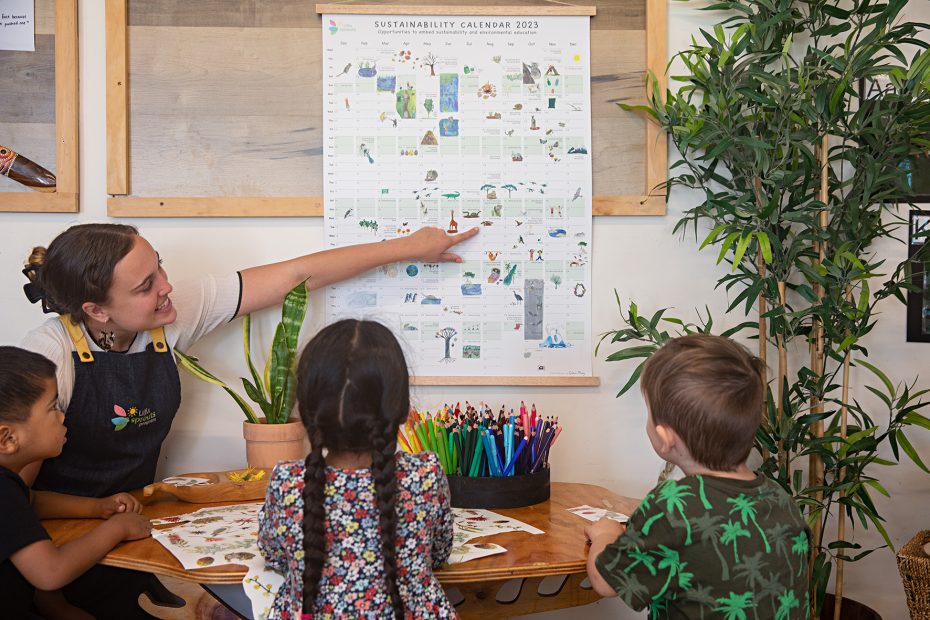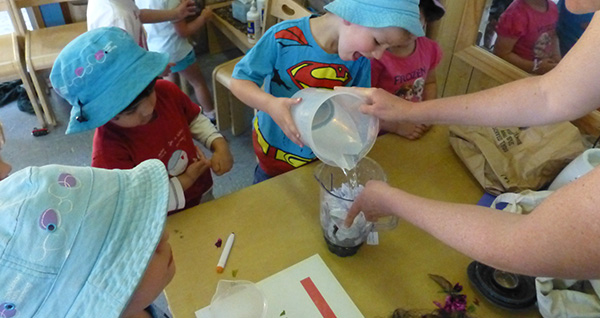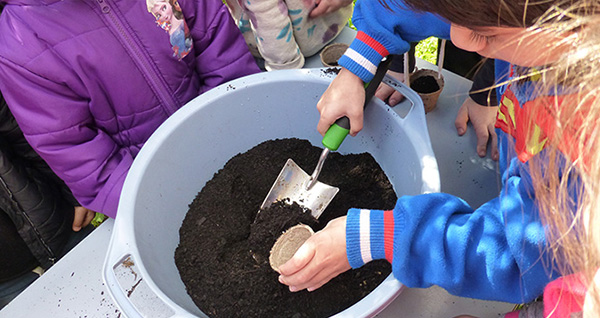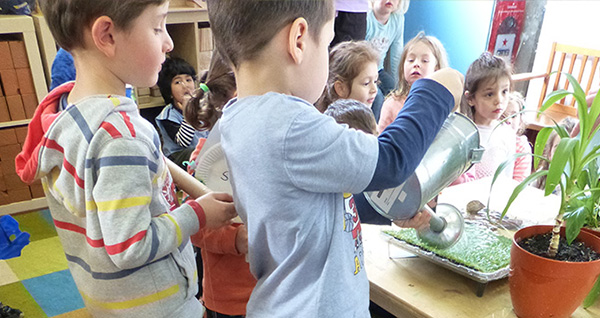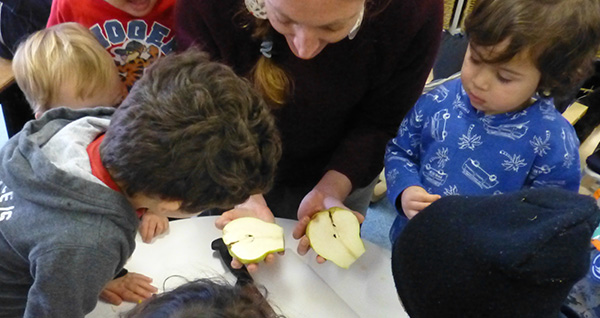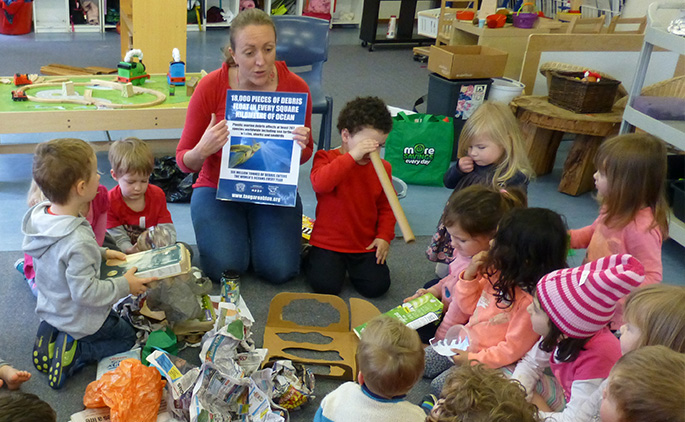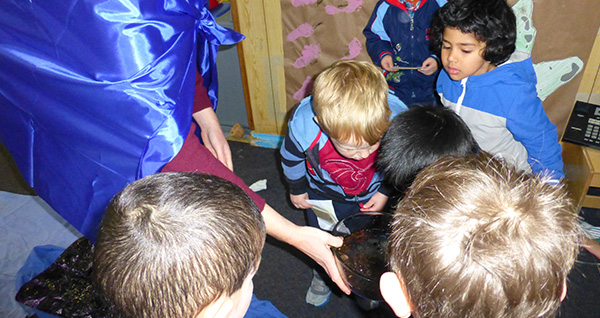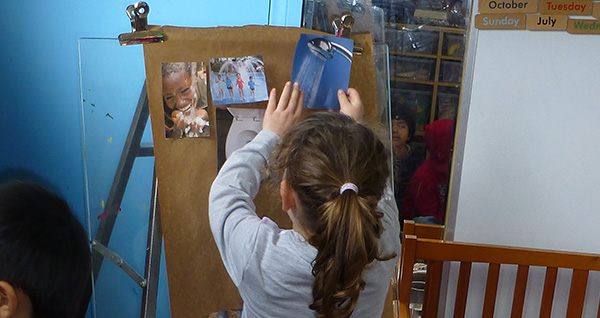It seems like almost every day is an awareness-raising day for something doesn’t it? The Little Sprouts Australian Sustainability Calendar supports you to easily see events linked to environmental education and sustainability across the full year, in one stunning, large calendar. Choosing the awareness dates you want to celebrate in advance, will help you work smarter, not harder. We developed this resource to inspire educators and nurture fresh ideas to help foster meaningful sustainability actions and environmental learning over the whole year.
Below is a guide on how to get the most out of your Little Sprouts Sustainability Calendar. This is aimed at those working in or with early learning however, it can be adapted for other services. For example, lower primary school, organisations such as Councils that support early childhood, environmental education, parents/carers of young children, and for marketing.

A must-have addition to your sustainability planning toolkit!
Our Sustainability Calendar is a handy resource to have in your educators toolkit. Why is the Sustainability Calendar useful?
- It features over 130 hand-picked celebration dates that we believe provide unique and exciting opportunities to explore environmental themes and inspire sustainability outcomes.
- We’ve done the hard work for you! – checking dates with national and international partners over many hours, to save you time. Say goodbye to looking through lots of different websites to develop your list of green events. Our calendar has all the key sustainability-themed event dates in one, handy place.
- To complement the celebration events, the calendar features 145 hand-painted artwork elements, created especially for this resource by Naarm (Melbourne) artist Claire Mosley. Children will love exploring all the different animals on our calendar!
- Bonus art print from Claire Mosley on the back to reuse after you’ve finished using the front calendar.
- A stunning ‘conversation starter’ to inspire sustainability activities and explore environmental concepts with children, staff, families, and your wider community.
- Encourages Aboriginal and Torres Strait Islander perspectives.
Links to learning outcomes
Celebrating sustainability events across the year leads to many diverse learning outcomes under the Australian Early Years Learning Framework, particularly under Outcome 2: Children are connected with and contribute to their world. It also supports outcomes described in Quality Area 3 of the National Quality Standard – The service cares for the environment and supports children to become environmentally responsible (QA 3.2.3). Furthermore, it provides an opportunity to build collaborative partnerships with families and communities to enhance children’s learning and play experiences (QA6).
Little Sprouts is committed to reconciliation. The Sustainability Calendar values and highlights opportunities to embed Aboriginal and Torres Strait Islander perspectives in the planning and implementation of environmental celebration dates. Indigenous Australians have been caring for Country for over 60,000 years. They are part of Country, and Country is part of them. Out of respect for Aboriginal and Torres Strait Islander peoples, Invasion Day (26 January) has been omitted from our calendar. We believe celebration dates should be inclusive and respectful.
Can we use the Sustainability Calendar for planning events again next year?
The short answer is no. Over 65% of the 131 dates featured in our calendar are fixed. Fixed dates will likely stay the same next year, just the day of the week will change. This means close to 35% of the dates on our calendar will change next year (date dependent on partners).
Don’t worry – we’ve got you covered! We will let you know when next year’s Little Sprouts Sustainability Calendar is ready for order. Subscribe to receive our emails to stay up to date.
Ready to pick the dates you want to celebrate?
Step 1: Get clear on your existing commitments and priorities
Do you ever get the feeling there are not enough hours in the day to achieve all you want to? Choosing which green dates you want to get involved in over the year and how you want to celebrate, helps you get clear on your focus and goals. We find December – February is good timing for reflection and planning of events for the year ahead.
What are your existing commitments?
Firstly, are there awareness dates (environmental, cultural, social, health, etc.) and other key activities you’ve already committed to this coming year? Are there awareness dates you always celebrate like Reconciliation Week? Busy periods leading up to Kinder graduation? Or perhaps you have an assessment and rating coming up at your childcare service?
List these dates so you can see where you may have time and space to celebrate new environmental events or expand on your existing celebrations.
Step 2: Explore our Sustainability Calendar for inspiration
Once you’ve got a clear understanding of your existing commitments and potential busy periods during the year, explore the Little Sprouts Sustainability Calendar.
Identify any sustainability or awareness-raising events on our calendar that you’re already committed to celebrating (make sure these are in your list from Step 1). Consider how you can look at planning these events through a refreshed sustainability lens? For example, growing your own flowers to give out for Mother’s Day? Or avoiding excess waste for Halloween celebrations.
Are there any sustainability calendar dates that may clash with the timing of your other priorities this year (listed in Step 1)?
What are your sustainability goals this year for example, in your Quality Improvement and/or Sustainability Plan? Could you achieve some outcomes of your goals through incorporating specific events in your calendar of activities for the year?
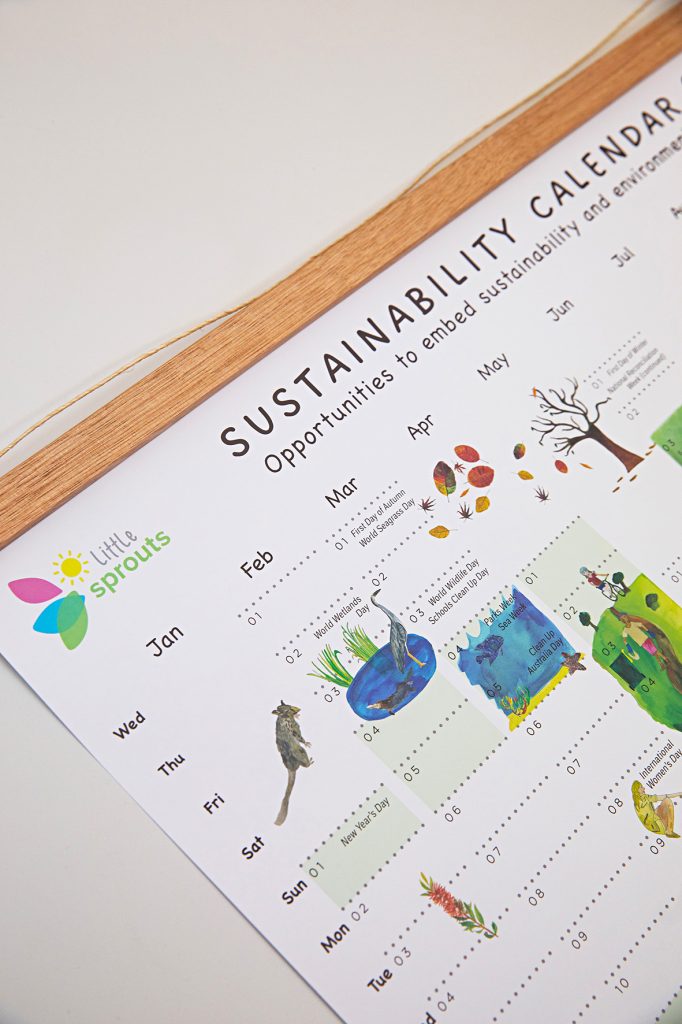

Step 3: Write a wish list
After getting excited and inspired by the events in our Sustainability Calendar, write a list of which new events you may be interested in exploring and celebrating this year. You may like to do this with other team members. You could also seek feedback from children and families on which topics and events they are interested in.
To help you refine your list, ask yourself the following questions:
- Which events make you truly excited? Motivation helps sustain our energy toward a goal.
- Do the events on my list provide a wide range of intentional experiences to support children to learn, develop and understand the world?
- Is there enough breathing space between the events on my list to effectively assess children’s learning, reflect, and potentially extend and enrich children’s learning and play further on environmental topics they are interested in? These events should be fun for you and children. That means making smart choices to allow for flexibility, to ensure you don’t get planning/event overwhelm or fatigue.
You may notice on the calendar that there are very busy periods with environmental dates. March, May, September, and October are jam-packed full of opportunities to explore and embed sustainability. However, we can’t do it all. Remember, there is always next year.
Some topics or themes are repeated over the year. If this is the case, then pick the best timing to celebrate these around your other service priorities.
*Tip: if you purchase our printed A1 calendar, you will receive a digital overview and web links for each of the events included in our calendar (plus extra dates that we couldn’t fit in our printed calendar). This is handy to search for keywords of interest.
Below are some examples of events or themes repeated over the 2024:
- If you’re interested in climate change, polar bears and the Arctic, there is International Polar Bear Day (27 February), Arctic Sea Ice Day (15 July), and Polar Bear Week (starting from 27 October).
- There are multiple opportunities throughout the year focused on clean ups: Schools Clean Up Day (1 March), Clean Up Australia Day (3 March), and World Cleanup Day (20 September).
- Interested in recycling, rubbish, and the impact of plastic? Check out Global Recycling Day (18 March), World Environment Day (5 June), Plastic Free July, and National Recycling Week (starting 11 November). If reducing your rubbish and reliance on plastic is something important to you, you could also integrate this into your planning for events that are well known for producing LOTS of plastic rubbish like Easter, Halloween, and Christmas.
- There are two World Migratory Bird Days over the year (11 May and 12 October) to mark the two peak days each year of the cyclical nature of bird migration and their migration along the world’s flyways in the northern and southern hemispheres.
- If you love frogs, there is World Frog Day (20 March) or Save the Frogs Day (28 April). There is also FrogID Week in November.
- If you want to explore the importance of pollination and how to protect pollinators like insects, birds and bats, there are several opportunities throughout the year to look at this topic from different perspectives – World Bee Day (20 May), World Cassowary Day (26 September), the Aussie Bird Count (14-20 October), Bat Week (24-31 October), and Australian Pollinator Week (9-17 November).
Step 4: Shorten your list
If we try to do everything, it can become so overwhelming that we end up doing nothing.
How many events is too many events to celebrate across a year? It’s a hard questions to answer as it depends on your goals and varies between different people and teams. For example, if you are planning multiple outcomes for one celebration event, this becomes more a sustainability action project which requires significant time and energy for planning, particularly if it’s your 1st time involved in the event. We recommend tackling no more than 1-3 new sustainability action projects, or expanding/changing existing sustainability projects, per year. To get an idea of the planning that can go into a celebration day, check out our blog for tips on how to celebrate Polar Bear Day in a holistic way.
However, if your goal is to run simple educational activities with your children around particular environmental awareness topics, you can most likely squeeze more event celebrations into your planning year.
If your list is still on the long side, download the handy guide below to help you focus and reduce your list so it’s achievable. Continue reading below for more handy tips on planning your sustainable celebration events.
Go through your list and brainstorm the following questions for each event.
Q. What do you want to achieve through participating in this event?
Make this a short and snazzy description. No more than 1-2 lines. For example:
Participating in Plastic Free July will help us learn with our children, staff, and families about the impact of plastic on the environment and take action to switch to plastic-free alternatives.
Q. How will you engage children, educators, families and/or the wider community in the events you want to celebrate?
Better learning outcomes can be achieved when we work in partnership with children, families, and local partners and topic experts. Could you reach out to local partners for support? For example, Councils often provide free native seedlings for celebrating events like National Tree Day.
How are you going to incorporate the diversity of your families in your planning of events and acknowledge, understand, share, and celebrate Aboriginal and Torres Strait Islander perspectives and connections to Country?
Q. What are the intended educational outcomes for children?
List potential learning opportunities for children as part of your event celebrations and how you might achieve this through learning and play ideas. How can you integrate Learning Outcomes of the EYLF into event activities? What different modes of learning could you use?
For example:
- Reading books and listening to music on the topic
- Sensory play ideas
- Art activities
- Incursions or excursions
- Outdoor activities
- An educational display about the topic/themes in the children’s room and/or front foyer.

Q. What outcomes do you want to achieve for the Earth?
This is where we move from education to action. How can you contribute to protecting and conserving the environment through your participation in these events? Here’s some examples.
- For Polar Bear Day – raising money for Polar Bears International, reducing the energy usage at your service, and providing information to families on how to reduce their energy use at home to look after polar bears and the Arctic.
- For Australian Pollinator Week, perhaps you could start a pollinator-attracting garden and/or giveaway pollinator-friendly plants for your families to plant at home? Or raise money for Wheen Bee Foundation?
- Looking to start a compost and/or worm farm system at your centre? These dates would be the perfect opportunity! – International Compost Awareness Week (5-11 May) or International Day of Awareness on Food Loss and Waste Reduction (29 September).
- Raise money for important conservation and research work for National Bilby Day (8 September).
- Contribute to data collection for science! Record frog calls in your local environment using the FrogID app during FrogID Week (November). Record the birds you see as part of the Aussie Bird Count (starting 14 October).
- Or it could be a commitment across the entire year to make sure you consider sustainability when purchasing or making gifts and running activities at your service. For example, reducing plastic packaging for gifts that go home to families during Easter, Mother’s Day, Father’s Day, Halloween, and Christmas. Putting on a plastic-free morning tea for your educators for Early Childhood Educators’ Day? How can packaging be recycled or composted after use?
- World Water Day (22 March), Global Handwashing Day (15 October) and/or National Water Week (21-27 October) provide wonderful opportunities to conduct a water audit, get involved in water quality monitoring, and/or implement actions to reduce water usage and protect water quality across your service.
Q. What do you need to prepare and by when?
Now that you have an idea of the activities and outcomes you’d like to achieve from your chosen events, map out the timing of any actions to help you reach your goals. For example:
- Is there any equipment or resources you may need? What’s the cost of this? Can you seek partnership support, donations, or a grant to help cover costs?
- If you would like to have Traditional Owners involved in your events, reach out early to secure their availability.
- Perhaps you’d like to book an excursion to your local zoo to explore animals e.g., linking with World Croc Day (17 June), Giraffe Day (21 June), Chimpanzee Day (14 July), Lion Day (10 August), Elephant Day (12 August), and so on… (there are lots of animal celebration days across the year!). Or get someone to visit to show Australian animals as part of Australian Wildlife Week (1-6 October)?
- Plan planting in your garden e.g., to give out Mother’s Day flowers. When do these need to be planted?
Little Sprouts has a range of sustainability incursion that link with many themes and topics in the Sustainability Calendar. Book an incursion with us in advance to time with an environmental celebration event at your centre!
Q. How will you communicate your plan?
Through using our guide, you should now have a better understanding of what you want to achieve and how much work is involved in each event. You may find you’ve reduced your list, or simplified your approach to make sure it is achievable. Now it’s time to communicate your plan.
Share the environmental events your service is celebrating this year with your children, staffing team, families, and local partners. Capture the general aims and outcomes in your planning (e.g., Sustainability Plan and/or Quality Improvement Plan). Get further input and help with your planning and allocate tasks so other people can help. Provide opportunities for educators to share their ideas for how they want to get their children involved.
You also may like to spread your message further through alerting local media of your activities. People love a good news story.
Q. How will you celebrate and reflect?
After each event you are involved in, take some time to celebrate and reflect on the experience. Seek input from others. What worked well? What would you change or do differently next time? Did you achieve your intended learning and play outcomes? Were there any unexpected outcomes? How did your actions help to protect and conserve the environment?
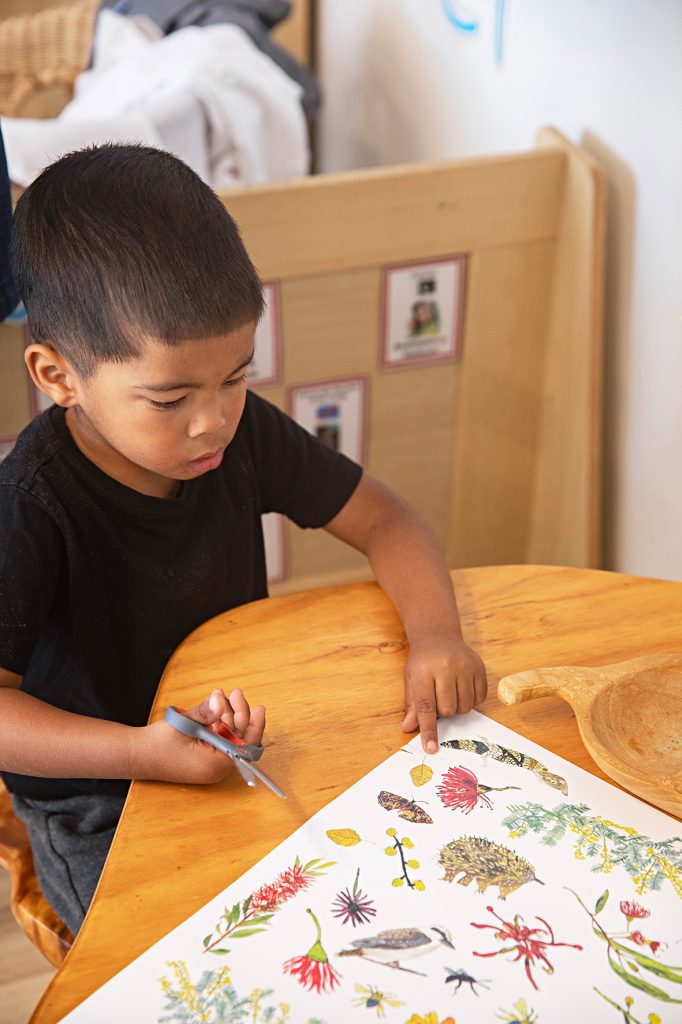
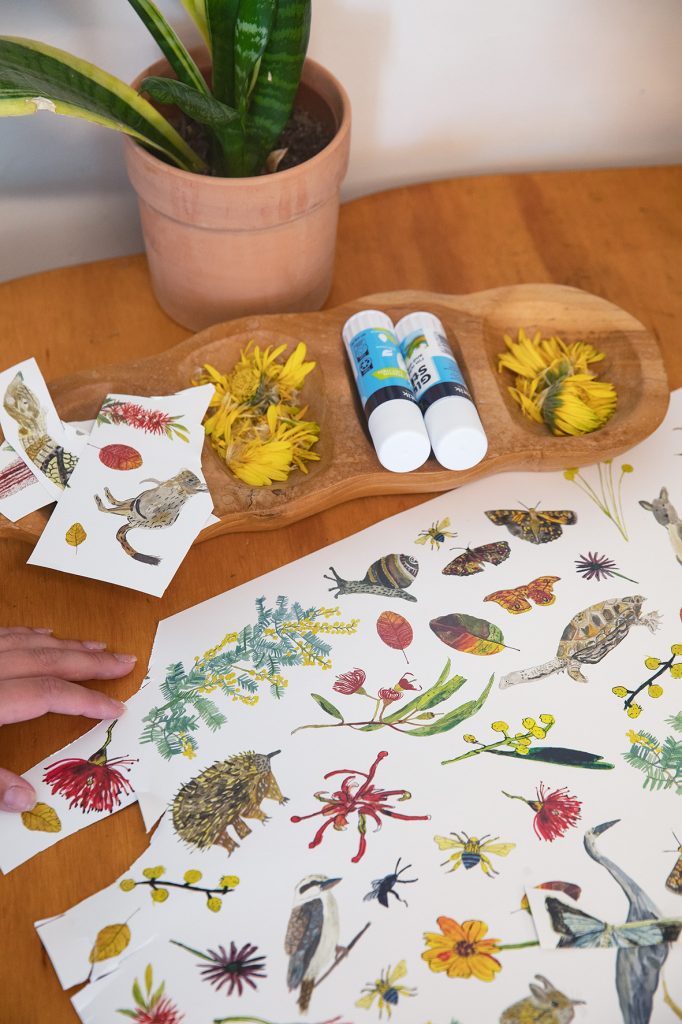
Ideas for what to do when you’re finished with the calendar…
The fun doesn’t stop when the year starts to wind down! When creating the Sustainability Calendar, we considered the full lifecycle of the product. We asked – what are people going to do with it after they’re finished using the calendar?
Here’s some tips on what to do with your calendar when the year is coming to a close:
- Flip it over to the other side to display a beautiful art print by Claire Mosley
- Cut up the images up on the back of the calendar to use in an art activity with children, as gift tags or decorations e.g., to spruce up your Christmas tree.
- Use the back of the calendar for gift wrapping
- Cut or rip up the calendar and make recycled paper out of it
- Lastly, please make sure to recycle the poster when you are finished with it.
You can purchase the Sustainability Calendar here.
Subscribe to receive our emails to be the first in the know when we launch next years’ Sustainability Calendar!
Have any questions or feedback? Please get in touch if you have any thoughts on how we can improve this resource for you in the future.

